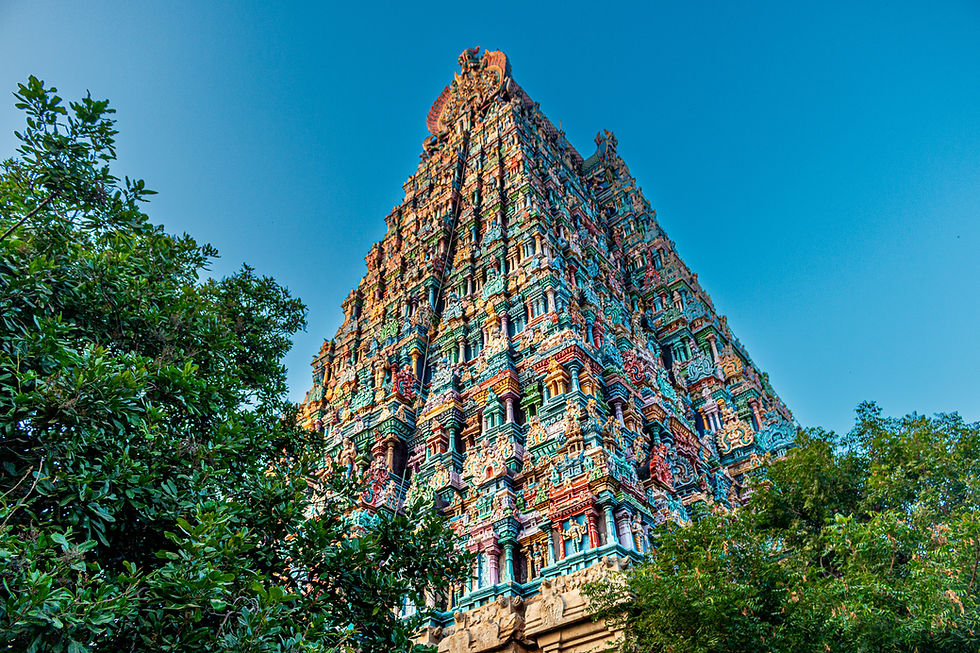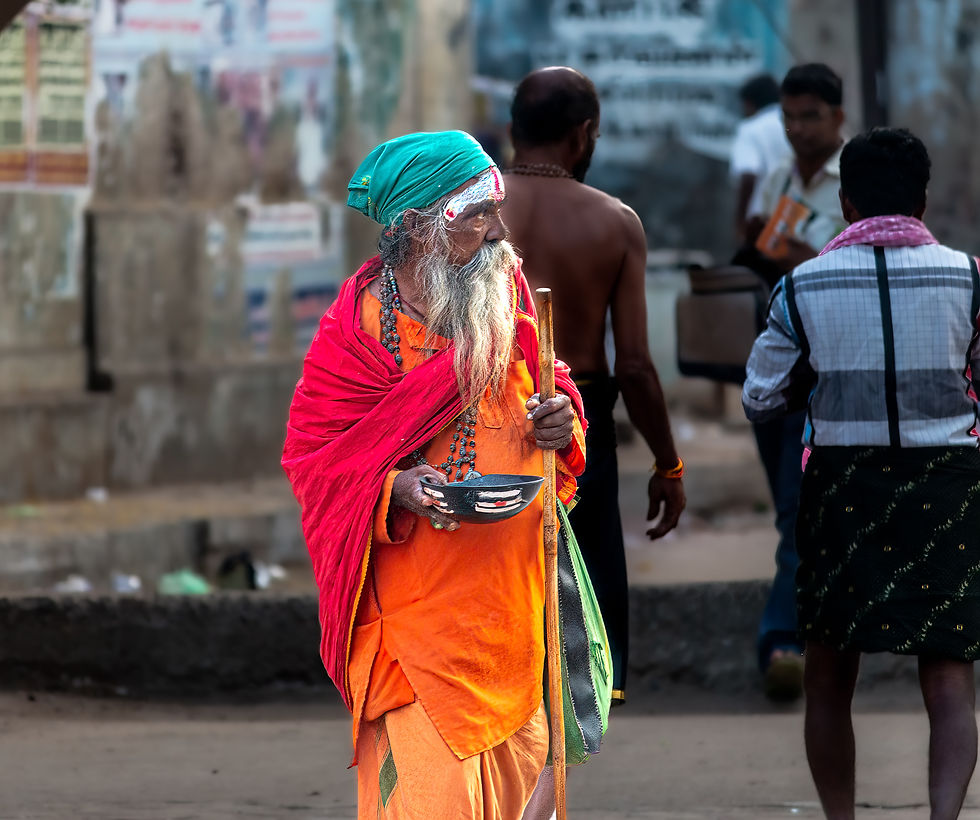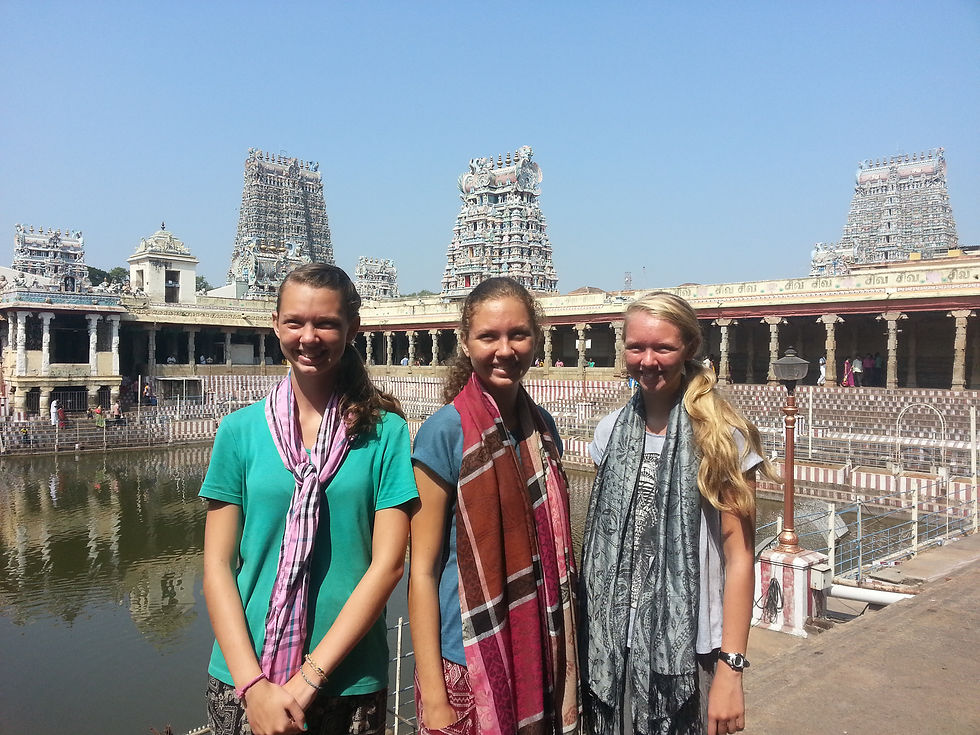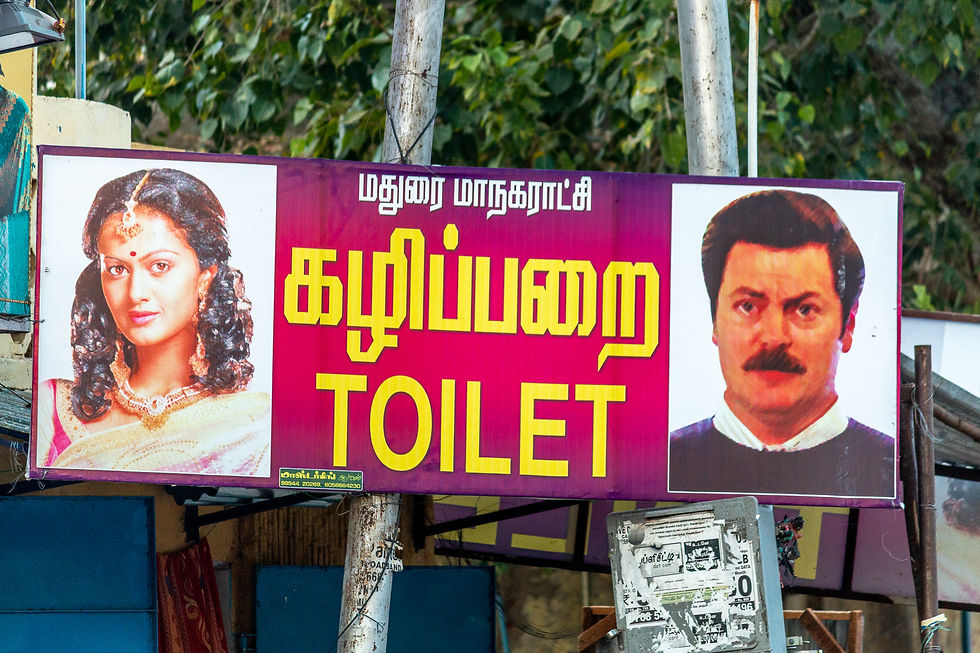Nuts and Bolts: Travel Tips for Visiting Madurai, India: Where a Bathroom Briefly Made My Wife Famous
- Rand Blimes

- May 8
- 8 min read

Nuts and Bolts posts give you the practical information you need, but without stripping away the humor, mishaps, and little victories that make real travel what it is. These aren’t just guides. They’re how we actually did it—mistakes, triumphs, and all.
This page has some travel tips for Madurai, India, to aid in planning your own trip. Remember, we are a family of five, and we travel mostly to eat. We were in Madurai in February 2016. If your trip to Madurai is significantly different from ours, you may have a very different experience.

The Unrestrained Majesty of Madurai
In many other countries, temple towns whisper, Madurai shouts. This city isn’t about subtle charms or curated experiences—it’s about full-volume devotion, rainbow-washed chaos, and some of the most unapologetically energetic street life we’ve ever seen. And it works. Somehow, it all works.
Between the gopurams, the gods, the paneer, the honking, and the occasional firecracker at our feet, the city practically dared us to love it. And we did.
But the most surreal thing that happened to us in Madurai is that for a brief period of time (15 minutes, if you will) my wife became famous because of a picture she took . . . of a public bathroom.
We loved Madurai, and if you want to try it for yourself, read on to find some of our best travel tips for visiting Madurai, India.
Travel Tips for Visiting Madurai, India: Madurai Weather
We were in Madurai in February of 2016. It was warm, but not hot. We planned our time in India with the hopes of staying ahead of the stifling hot weather and monsoon flooding. So, the weather we experienced in Madurai was quite pleasant. The downside of that is things are more crowded and more expensive.
We didn’t experience any significant rainfall, or other weather events that were enough to force us to adapt our plans.
Getting to Madurai
We flew into Madurai from Sri Lanka on a budget airline (SpiceJet, if you’re curious), and stepped straight into the chaotic bliss of South India. The airport is small (for India), functional, and comes with a healthy serving of bureaucracy—be ready for lots of lines, all of them vaguely official. It should go without saying that your paperwork better be in order.
If you're coming from elsewhere in India, Madurai is also well-connected by train and bus. Trains roll in from Chennai, Rameswaram, and Kochi. If you’re brave enough to tackle India’s rail system (and you should—it’s half the adventure), Madurai Junction is a major hub with plenty of options, including overnight sleeper routes (how we traveled across most of India).
Buses, both government-run and private, arrive regularly from places like Trichy, Coimbatore, and Pondicherry. You won’t find much luxury, but you will find inexplicable horn patterns and possibly a Bollywood movie blasting at full volume.
Whether by plane, train, or bus, getting to Madurai isn’t hard—it just might be a little chaotic. But then again, that’s kind of the point.
Sleeping in Madurai for the Cheapskate Family
Because Madurai was our first stop in India, I booked our hotel online ahead of our arrival: the Hotel Rani. It was a simple, clean hotel that hit the sweet spot: easy walk to the temple, but quiet enough at night that we weren’t kept up all night by the devout celebrating their pilgrimage to the city. Please note that when I say it was “quiet” I mean quiet for India. There was a fairly large street nearby, (and a train station) and you could certainly hear traffic from the room. But we never heard massive firecrackers going off. So, it was “quiet.”
Some general advice:
Madurai has its fair share of cheap guesthouses and midrange hotels—but location really matters here. You might think staying right next to the Meenakshi Temple sounds ideal. It’s not. That area is loud. Like, fireworks-at-dawn, processions-at-midnight loud. Sacred and beautiful? Absolutely. Sleep-friendly? Not so much.
We recommend finding a place that’s about a 15 minute walk of the temple complex. That puts you close enough to soak it all in, but far enough to get at least a few hours of uninterrupted rest (if you are lucky).
And find a place that has a rooftop restaurant. Meenakshi’s towers rise about the rooftops of Madurai, and it is a wonderful thing to sit on top of the world and watch the flocking birds swirl in the sunset over the temple.
Getting Around
Madurai is not a big city by Indian standards, and most of what you’ll want to see is clustered around the Meenakshi Temple, which makes it surprisingly walkable—if you’re okay dodging motorbikes, auto rickshaws, and the occasional cow (yes, there really are cows wandering around everywhere—it is awesome).
We walked almost everywhere. The temple, markets, food spots—all were within 20 minutes of our hotel. Walking in Madurai isn’t exactly peaceful, but it is immersive. It drops you straight into the heartbeat of the city. Just remember: crossing the street is a learned skill, not a right-of-way negotiation. Be confident, predictable, and—if you’re lucky—surrounded by locals doing the same.
The only time we moved by means other than our own feet in Madurai was the taxi we got from the airport to the hotel. We did all our sightseeing in the city by foot. And when we left, well . . . we basically just needed to cross the street to get to the train station.
Eating in Madurai (aka, How to Be Joyfully Vegetarian)
First things first: eat on rooftops. This is true of other Indian cities as well (Jaisalmer!). The rooftops in Madurai are just glorious.
Honestly, we had no food plan when we showed up in Madurai. Most of the tourism in Madurai is Indian tourism, so stick to Indian food. In fact, I would say stick to southern Indian food.
South Indian food is a glorious, spicy, carb-forward celebration of breakfast-for-every-meal. Even if you’ve had “Indian food” elsewhere, it probably wasn’t this. Madurai is dosa territory—thin, crispy crepes made of fermented rice and lentil batter, often rolled around a spicy potato filling. Trust me on this: if you find yourself in South India, eat all the dosa you can . . . because it is devilishly difficult to find good dosa outside of South India. Eat it while you are here, or live in regret.
You’ll also find idli (fluffy steamed rice cakes), vada (savory fried doughnuts), and uttapam (like a thick dosa with onions, chilies, or tomatoes cooked right in).
All of it is served with a rotation of sambar (a thin lentil-based veggie stew) and chutneys, from coconut to mint to spicy red mystery.
Meals are often served on banana leaves, and even the simplest street-corner place will likely deliver a sensory overload of flavor. And while meat is available, vegetarian food is the default here—and it’s anything but boring.
Pro tip: skip the Western food. Just dive into the local stuff. Your mouth might catch fire, but your soul will thank you.
What To Do
Meenakshi Amman Temple Complex
Let’s be honest: you came to Madurai for the temple. The Meenakshi Amman Temple is the headliner, the main act, the show you’ll still be talking about weeks later. And rightly so—it’s enormous, colorful, and fabulously overwhelming. You can visit it multiple times and still not see everything.
Meenakshi is a classic example of a Dravidian-style temple, the kind you mostly find in South India. These temples aren’t shy. They’re built like fortresses, walled compounds with massive gateway towers called gopurams that are absolutely plastered with colorful carvings—gods, demons, animals, mythical creatures, all stacked like a divine game of Jenga.
Inside, it’s a maze of pillared halls, shrines, and courtyards, often dark, echoey, and soaked in incense. It’s not a quiet, reflective temple experience—it’s alive, filled with movement, devotion, and the rhythmic clang of bells.
Non-Hindus are allowed in the temple. When we first went, shopkeepers tried to tell us that women needed to cover their heads with a scarf to go inside. And (what do you know?!) they had some scarves handy to sell us. But we came prepared! The wife and daughter had their own scarfs just for such occasions.
Of course, when we entered the temple, we saw many women not wearing scarves. So it seemed like it was an attempted scam. But hey, Meenakshi is a cool place to buy a scarf if you want one. Don’t be coerced if you don’t want one. Bargain hard if you do.
We hired a guide to take us through the temple, and it was absolutely worth it. Our guide’s name was Raj, and he really helped us understand not only the specifics of the temple, but Hinduism in general as well. Raj transformed the temple complex from simply a stunning visual experience, into an opportunity for cultural learning.
Guide services are available at the temple entrance and through various online platforms. Prices typically range from ₹500 to ₹2,500 (approximately $6 to $30 USD), depending on the duration and depth of the tour. You will get a much better price turning up at the temple complex and finding a guide than you will by booking one ahead of time on Get Your Guide, etc. If you care about such things (and it is probably a good idea to care), ensure your guide is authorized by the temple (otherwise you may run into some issues inside the complex).
And agree not only on the specific price, but exactly what the tour will entail before you pay.
Do not hire a guide who tells you that he will simply take you around the temple and you can pay “whatever you think” after the tour. Don’t do that here. Or anywhere. You will end up either paying way too much, or making a huge scene (or worse). Agree to a price ahead of time.

Get Famous
Several times, we would go and join the pilgrims in walking circuits around the Meenakshi Temple complex itself—a practice known as pradakshina. In the evenings especially, it’s common to see both locals and pilgrims walking barefoot around the outer walls of the temple, often in quiet reflection, chanting, or simply soaking in the spiritual energy of the site. The temple is not just a building—it’s a living, breathing sacred space, and walking around it is a form of devotion.
While walking around, and around, and around the temple complex, at some point, one might need to relieve one's self. Which is the situation I found myself in one evening. So I looked around for a public bathroom to use.
And I saw one.
The bathroom had a sign designating restrooms for women and men. The women’s restroom was designated by a picture of an India woman.
The men’s was designated by . . . wait a minute! That is Ron Swanson!

The picture designating the men’s toilet had a picture of Nick Offerman, the American actor, who played one of my all-time favorite TV characters, Ron Swanson, on the show Parks and Rec.
And I get it. Offerman was sporting a mustache that was the very image of masculinity. It wasn't just facial hair—it was a declaration of testosterone. It looked like it could have fought in a war, run for office, and fathered several smaller, less impressive mustaches.
So, we took some pictures of Nick Offerman’s manly mug perched over the pilgrims of Madurai.
And we posted them to our social media.
And it turned out my wife had a friend, who had a friend, who actually knew Nick Offerman. And retweeted my wife's post. And then Offerman retweeted it! Eventually, a news reported contacted my wife to get her permission to use her tweet.
It was a surreal experience. You can read my wife’s more detailed account here.
In the end, Madurai was unforgettable to us. The temple, the streets, the food, the honking—it all blended into something messy and marvelous. For us, Madurai wasn’t just another stop. It was where we got our travel legs back. Where we remembered that the best kind of travel isn’t polished or comfortable—it’s alive, and it is sometimes screaming at you.
Throwing yourself into travel is joining a barefoot stream of pilgrims at dusk, worrying about free roaming cows, navigating tuk tuks like a live-action video game.
And we thought that was all we had come to Madurai for, but because travel, my wife also got to have her moment in the global spotlight.



Comments